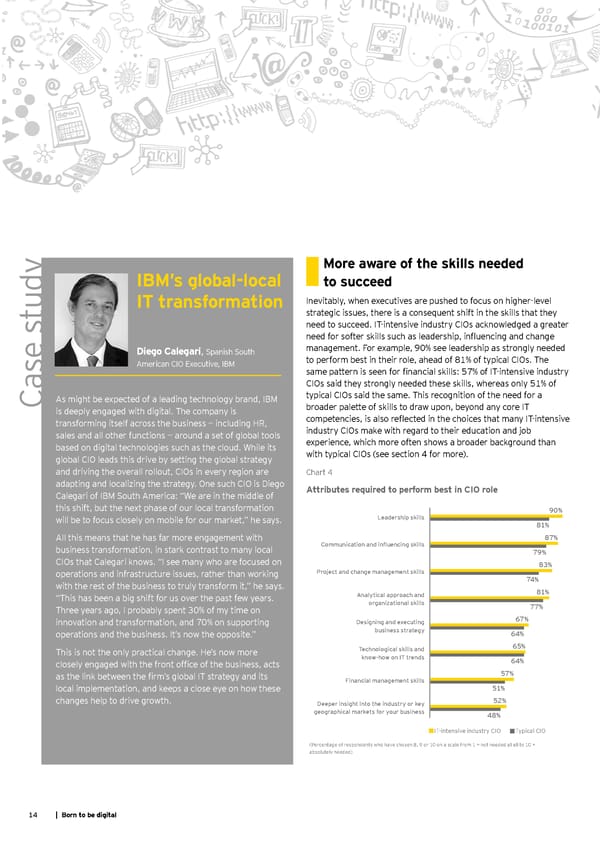More aware of the skills needed IBM’s global-local to succeed udy IT transformation Inevitably, when executives are pushed to focus on higher-level t strategic issues, there is a consequent shift in the skills that they need to succeed. IT-intensive industry CIOs acknowledged a greater need for softer skills such as leadership, influencing and change e s Diego Calegari, Spanish South management. For example, 90% see leadership as strongly needed American CIO Executive, IBM to perform best in their role, ahead of 81% of typical CIOs. The same pattern is seen for financial skills: 57% of IT-intensive industry as CIOs said they strongly needed these skills, whereas only 51% of C As might be expected of a leading technology brand, IBM typical CIOs said the same. This recognition of the need for a is deeply engaged with digital. The company is broader palette of skills to draw upon, beyond any core IT transforming itself across the business — including HR, competencies, is also reflected in the choices that many IT-intensive sales and all other functions — around a set of global tools industry CIOs make with regard to their education and job based on digital technologies such as the cloud. While its experience, which more often shows a broader background than global CIO leads this drive by setting the global strategy with typical CIOs (see section 4 for more). and driving the overall rollout, CIOs in every region are Chart 4 adapting and localizing the strategy. One such CIO is Diego Attributes required to perform best in CIO role Calegari of IBM South America: “We are in the middle of this shift, but the next phase of our local transformation 90% will be to focus closely on mobile for our market,” he says. Leadership skills 81% All this means that he has far more engagement with 87% business transformation, in stark contrast to many local Communication and influencing skills 79% CIOs that Calegari knows. “I see many who are focused on 83% operations and infrastructure issues, rather than working Project and change management skills with the rest of the business to truly transform it,” he says. 74% “This has been a big shift for us over the past few years. Analytical approach and 81% Three years ago, I probably spent 30% of my time on organizational skills 77% innovation and transformation, and 70% on supporting Designing and executing 67% operations and the business. It’s now the opposite.” business strategy 64% This is not the only practical change. He’s now more Technological skills and 65% closely engaged with the front office of the business, acts know-how on IT trends 64% as the link between the firm’s global IT strategy and its 57% Financial management skills local implementation, and keeps a close eye on how these 51% changes help to drive growth. Deeper insight into the industry or key 52% geographical markets for your business 48% IT-intensive industry CIO Typical CIO (Percentage of respondents who have chosen 8, 9 or 10 on a scale from 1 = not needed at all to 10 = absolutely needed) 14 | Born to be digital
 Born to be Digital Page 17 Page 19
Born to be Digital Page 17 Page 19